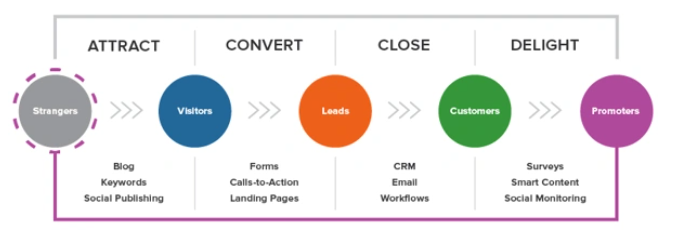How Web Design Impacts Lead Generation
Your website is the first impression that potential customers have of your business. It is also the place where you can generate leads by showcasing your products or services, offering incentives, and providing valuable information. But how do you design a website that attracts and converts visitors into leads?
![]()
In this blog post, I will explore how web design impacts lead generation and share some tips on how to optimize your website for lead generation.
Lead Generation
Lead generation is the process of attracting and capturing the interest of potential customers for your business. Leads are people who have shown some level of interest in your products or services but have not yet made a purchase decision. The goal of lead generation is to nurture these leads until they are ready to buy from you.
Your website's design plays a vital role in lead generation. It can either attract or repel visitors, depending on how well it meets their expectations and needs. Here are some of the ways that web design affects lead generation:
First Impressions
According to a study by Google, it takes only 50 milliseconds for users to form an opinion about a website. That means you have less than a second to impress your visitors and make them want to stay on your website. A good web design should be visually appealing, professional, and consistent with your brand identity.
User Engagement

Once you have captured the attention of your visitors, you need to keep them engaged with your website content. A good web design should be easy to navigate, fast to load, and responsive to different devices. It should also provide clear and compelling headlines, subheadings, bullet points, images, videos, and other elements that break up the text and make it more readable and interesting.
This is why working with a web design agency can be a great investment for your business. A professional web design agency not only understands the technical aspects of design but also brings expertise in user experience (UX), visual hierarchy, and content strategy. They can help you create a cohesive, branded experience that guides visitors smoothly through your site, encourages longer visits, and ultimately drives conversions. Whether you're building a new site or revamping an existing one, collaborating with experts ensures your digital presence leaves a lasting impression.
Conversion Optimization
The ultimate goal of lead generation is to convert your visitors into leads by persuading them to take the desired action on your website. A good web design should have a clear and prominent CTA that tells your visitors what you want them to do next, such as signing up for a newsletter, downloading an ebook, requesting a quote, or scheduling a consultation. It should also have a simple and user-friendly form that collects only the necessary information from your leads.
Search Engine Optimization

One of the ways to drive more traffic to your website is by ranking higher on search engines like Google or Bing. A good web design should follow the best practices of search engine optimization (SEO), such as using relevant keywords, optimizing meta tags, creating a sitemap, and using SSL encryption. It should also have a fast loading speed, mobile-friendliness, and low bounce rate, which are some of the factors that affect your SEO ranking.
Tips to Improve Your Web Design for Lead Generation
If you want to improve your web design for lead generation, here are some tips that you can follow:
1. Know your target audience
Before you design your website, you need to understand who your target audience is and what they are looking for. You can use tools like Google Analytics or Hotjar to analyze your website traffic and user behavior. You can also conduct surveys or interviews with your existing or potential customers to get their feedback and preferences.
2. Use a professional website design company
If you are not confident or experienced in web design, you may want to hire a professional website design company to help you create a stunning and effective website for lead generation. A professional website design company can provide you with expert advice, customized solutions, and quality results.
3. Add Case Studies

To make your web design more convincing and credible, you can add some statistics, examples, or case studies that show how web design impacts lead generation. For instance, you can mention how HubSpot, a leading marketing software company, increased its conversion rate by 35% by redesigning its homepage with a clear value proposition and CTA button.
4. Include a Call to Action
At the end of your blog post, you should include a conclusion that summarizes your main points and provides a clear call to action for your readers. For example, you can invite them to contact you for more information, check out your portfolio, or subscribe to your newsletter.
How to Measure the Effectiveness of Your Web Design for Lead Generation
After you have implemented the web design tips that we have shared, you may want to measure the effectiveness of your website for lead generation. This will help you identify what works and what doesn’t and make improvements accordingly.
There are various metrics that you can use to measure the effectiveness of your web design for lead generation, such as:
1. Traffic
This is the number of visitors that come to your website from different sources, such as search engines, social media, email, etc. You can use tools like Google Analytics to track your traffic and see which sources are driving the most visitors to your website.
2. Bounce rate
This is the percentage of visitors who leave your website after viewing only one page. A high bounce rate indicates that your website is not engaging or relevant enough for your visitors. You can use tools like Hotjar to analyze your bounce rate and see where your visitors are dropping off.
3. Conversion rate

This is the percentage of visitors who complete a desired action on your website, such as filling out a form, downloading an ebook, or making a purchase. A high conversion rate indicates that your website is persuasive and effective in generating leads. You can use tools like HubSpot to track your conversion rate and see which pages or elements are converting the most visitors into leads.
4. Lead quality
This is a measure of how qualified and interested your leads are in your products or services. A high lead quality indicates that your website is attracting the right audience and providing them with valuable information. You can use tools like Leadfeeder to identify your leads and see what pages they visited, how long they stayed, and what actions they took on your website.
By measuring these metrics, you can evaluate the performance of your web design for lead generation and optimize it accordingly. You can also conduct A/B testing to compare different versions of your web design and see which one generates more leads.
Conclusion
In conclusion, web design has a significant impact on lead generation. An effective website design that appeals to your target audience and convinces them to convert can be a powerful driver of quality leads.
Ensure your website is professionally designed, optimized for conversions and SEO, and equipped with clear calls to action. Continuously measure and refine your web design to boost engagement and maximize lead generation.







